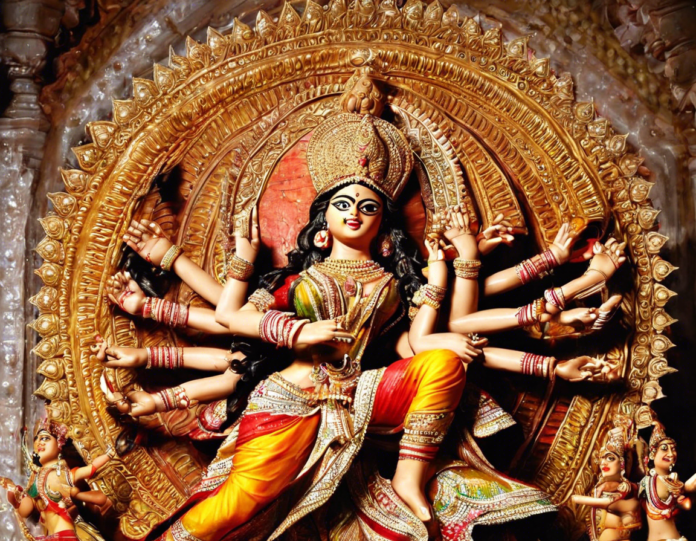Durga Puja, also known as Sharadotsav, is a significant Hindu festival celebrated with immense zeal and enthusiasm, primarily in the Indian states of West Bengal, Odisha, Assam, Tripura, and Bihar, as well as in Bangladesh. The festival marks the victory of Goddess Durga over the demon Mahishasura, symbolizing the triumph of good over evil.
With the countdown to Durga Puja already underway, devotees and enthusiasts are gearing up for the grand celebration of this auspicious occasion. As the fervor and excitement build up, let’s delve into the significance, rituals, and preparations associated with this vibrant festival.
Significance of Durga Puja
Durga Puja holds a special place in the hearts of millions of devotees worldwide. This festival is celebrated to honor Goddess Durga, also known as the divine mother, who epitomizes power, strength, and compassion. The occasion signifies the homecoming of Goddess Durga along with her four children—Lakshmi, Saraswati, Kartikeya, and Ganesha—all riding on varied vehicles, to her parental home.
The festival also symbolizes the victory of good over evil, as it commemorates the defeat of the buffalo demon Mahishasura at the hands of Goddess Durga. The intricate rituals performed during Durga Puja are a way of invoking the blessings of the goddess and seeking her divine grace for prosperity, well-being, and protection.
Rituals and Traditions
Durga Puja is celebrated over a span of nine days, known as Navaratri. Each day has special significance and is dedicated to different forms of Goddess Durga. The festival commences with Mahalaya, the day when Goddess Durga is invoked and welcomed on earth, and concludes with Vijayadashami, marking the triumph of good over evil.
Key rituals and traditions observed during Durga Puja include:
1. Pran Pratishtha (Consecration):
On the day of Mahashasthi, the ritual of Pran Pratishtha is performed when the priest invokes the presence of Goddess Durga into the idols. This ritual marks the beginning of the festival.
2. Shashthi, Saptami, Ashtami, and Navami Puja:
Each day of Durga Puja is dedicated to the worship of a specific form of Goddess Durga. The rituals involve chanting of mantras, offering of flowers, incense, and bhog (prasad), and performing aarti.
3. Sandhi Puja:
A significant ritual observed during Durga Puja, Sandhi Puja is performed at the juncture of Maha Ashtami and Maha Navami. It is believed that during this time, Goddess Durga killed the buffalo demon Mahishasura.
4. Sindoor Khela:
On Vijayadashami, married women apply vermilion (sindoor) to the goddess and to each other, symbolizing the blessings of a long and prosperous married life. This ritual is followed by women playing with sindoor, singing, and dancing.
5. Visarjan:
The festival culminates with the immersion of the idol of Goddess Durga in water bodies like rivers or lakes. This ritual signifies the departure of the goddess and her journey back to her celestial abode.
Preparations and Celebrations
The celebration of Durga Puja involves meticulous preparations, elaborate decorations, cultural programs, grand pandal (temporary shrine) constructions, and extravagant feasting. The entire community comes together to organize and participate in the festivities, creating a vibrant and joyous atmosphere.
Key preparations and celebrations include:
1. Pandal Decorations:
Elaborate pandals are set up, reflecting various themes like traditional, contemporary, historical, or social issues. These pandals are adorned with decorative lights, artwork, and embellishments to attract visitors.
2. Shopping and Attire:
People indulge in extensive shopping for new clothes, jewelry, accessories, home decor items, and gifts. Traditional attire like sarees, kurta-pajamas, and dhotis are worn during the puja days.
3. Cultural Programs:
Cultural events like dance performances, music concerts, drama shows, and art exhibitions are organized in the vicinity of the pandals to entertain the visitors and showcase local talent.
4. Food and Prasad:
Delicious food offerings, known as bhog, are prepared and distributed among devotees as prasad. Special delicacies like khichuri, labra, chutney, payesh, and luchi are served as part of the festive feast.
5. Community Involvement:
Durga Puja is a community festival where people from all walks of life come together to celebrate. The committee members, volunteers, sponsors, and visitors collectively contribute to the success of the event.
FAQs (Frequently Asked Questions)
Q1. What is the significance of Durga Puja?
A1. Durga Puja is celebrated to honor Goddess Durga and commemorate her victory over the demon Mahishasura, symbolizing the triumph of good over evil.
Q2. How long does Durga Puja last?
A2. Durga Puja is celebrated over a span of nine days, known as Navaratri, culminating with Vijayadashami.
Q3. What are the key rituals observed during Durga Puja?
A3. The key rituals include Pran Pratishtha, Shashthi, Saptami, Ashtami, and Navami Puja, Sandhi Puja, Sindoor Khela, and Visarjan.
Q4. How is Durga Puja celebrated in different regions of India?
A4. Durga Puja is celebrated with regional variations in West Bengal, Odisha, Assam, Tripura, Bihar, and other states, each adding their unique customs and traditions to the festivity.
Q5. What is the significance of sindoor khela during Durga Puja?
A5. Sindoor Khela is a ritual where married women apply vermilion to the goddess and to each other, symbolizing blessings for a prosperous married life.
Q6. Why is Visarjan performed during Durga Puja?
A6. Visarjan marks the conclusion of the festival and symbolizes the departure of Goddess Durga back to her celestial abode after her annual visit to earth.
Q7. How are pandals decorated during Durga Puja?
A7. Pandals are decorated elaborately with themes, lights, artwork, and embellishments to create a visually stunning ambiance for visitors.
Q8. What are some traditional dishes served during Durga Puja?
A8. Special dishes like khichuri, labra, chutney, payesh, luchi, and various sweets are prepared and served during the festive feast known as bhog.
Q9. How do people participate in Durga Puja celebrations?
A9. People participate by attending puja ceremonies, visiting pandals, enjoying cultural programs, socializing, feasting, and engaging in community activities.
Q10. What is the spiritual significance of Durga Puja for devotees?
A10. Durga Puja is a time for devotees to seek blessings, spiritual rejuvenation, inner peace, and divine grace from Goddess Durga for personal and collective well-being.
As the days tick by, the anticipation and enthusiasm for Durga Puja continue to grow, heralding the onset of one of the most vibrant and culturally rich festivals in India. The festival not only brings communities together but also fosters a sense of unity, devotion, and joy among all who partake in its celebrations. Let the countdown to Durga Puja mark the beginning of a joyous and spiritually fulfilling journey for all devotees and participants alike.




